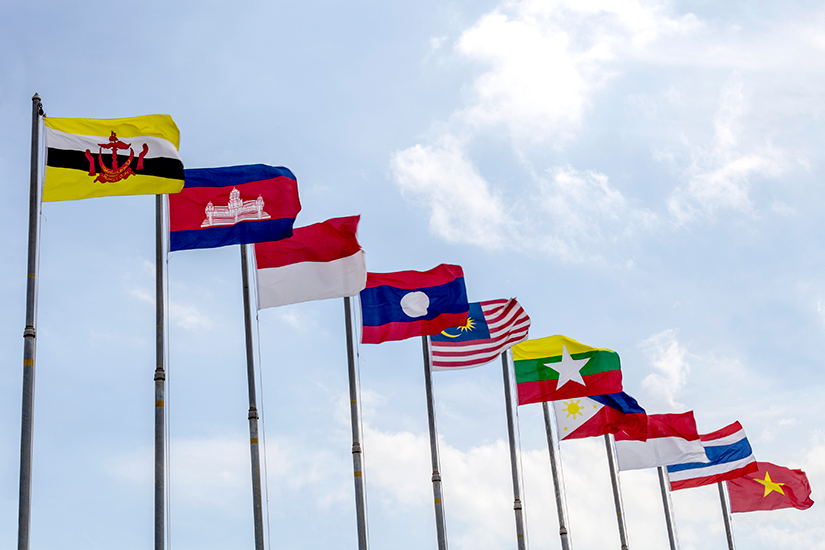Following Donald Trump's victory in the US presidential election of November 5, 2024, attention has focused on who will serve in his second-term cabinet to be launched in January 2025, as well as on the administration's policies, including foreign policy. Member states of the Association of Southeast Asian Nations (ASEAN) recognize they may be greatly affected by Trump's hardline stance toward China, his claims to quickly end the war in Ukraine, his expected emphasis on striking bilateral trade "deals," and his demands that allies share a bigger defense burden. Relations with Washington have a major bearing on the economy and security of the region, and there is great concern about the course the incoming administration will take. The following review will look back on US-ASEAN ties during the first Trump term and the Joe Biden years, before offering a preview of how the relationship is likely to develop under Trump 2.0.

Trump's First Term: No Interest in Multilateralism
ASEAN's relations with the United States during the first Trump administration (2017–2021) were not very smooth. Trump withdrew from the Trans-Pacific Partnership (TPP) shortly after he entered office, disappointing many in ASEAN who had looked forward to US leadership in advancing multilateral economic cooperation in the Asia-Pacific. The president showed no personal interest in ASEAN's multilateralism, moreover, and betrayed the region's expectations by never attending the East Asia Summit during his term and never getting around to appointing an ambassador to ASEAN or to Singapore.[1]
And while he remained equally indifferent about pursuing bilateral ties with ASEAN members, he nonetheless adhered to his America First agenda in brokering deals to demand correction of trade imbalances, even with much smaller ASEAN economies.
There were, however, aspects of the Trump presidency that some ASEAN countries found quite advantageous. Washington escalated tensions with Beijing by clearly identifying China as a strategic competitor and sharply criticizing its strong-arm tactics in the South China Sea. China's aggressive behavior was countered with a show of strength, such as by doubling freedom of navigation operations through the South China Sea—conducted once every three to five months under the Barack Obama administration—to once every one to two months[2].
ASEAN countries also benefited economically from the US-China trade war, as many companies, including Chinese firms, shifted production to ASEAN to avoid tariffs on Chinese imports to the US market, resulting in a robust expansion of US-ASEAN trade.[3]
The Biden Years: From Hope to Disappointment and Stagnation
When Joe Biden entered the White House in 2021, ASEAN hoped that the United States would engage with the region in a way that was aligned with its interests. This was out of nostalgia for the importance the Obama administration placed on ASEAN's multilateralism and on the president's attendance at the East Asia Summit. Obama sought to advance multilateral economic cooperation in the Asia-Pacific region by expanding the TPP. Biden was then vice-president, so many in ASEAN hoped that Washington would once again embrace the multilateral approach.[4]
US policy toward ASEAN was generally in line with ASEAN's expectations during 2022. In May, Biden hosted the US-ASEAN Special Summit in Washington—only the second meeting of the grouping's leaders in the United States following a gathering held during the Obama administration. The summit's Joint Vision Statement outlined cooperation in eight areas that ASEAN deemed important, including fighting the COVID-19 pandemic, strengthening economic cooperation and connectivity, promoting maritime cooperation, and addressing climate change.[5] And in November, Biden attended the US-ASEAN Summit in Cambodia, where the relationship was elevated to the highest level of a comprehensive strategic partnership.[6]
Biden's enthusiasm for ASEAN's multilateralism waned thereafter, however, as he skipped the East Asia Summit in 2023 and 2024. In the latter half of his administration, he looked, instead, to boost bilateral ties with an eye toward China. In September 2023, he visited Hanoi, raising the US-Vietnam relationship to a comprehensive strategic partnership, but failed to attend the East Asia Summit that was held the same month in Jakarta. He also strengthened relations with the Philippines through the rapid institutionalization of bilateral defense cooperation, such as by expanding US military deployment under the Enhanced Defense Cooperation Agreement (EDCA), signing defense guidelines, establishing regular foreign and defense ministerial meetings (2+2), and concluding a General Security of Military Information Agreement (GSOMIA).
Casting a shadow over US-ASEAN relations was the US response to the conflict in Gaza. Many in Malaysia, for instance, resented Washington's strong backing of Israel, prompting the Anwar Ibrahim administration to express its support for Hamas and further eroding US-Malaysia relations.[7] This likely also prompted Malaysia to apply for membership in BRICS.[8] In an opinion poll conducted annually since 2019 by Singapore's ISEAS–Yusof Ishak Institute (formerly known as the Institute of Southeast Asian Studies), China outgained the United States as a preferred partner for the first time, indicating ASEAN's disappointment with the Biden administration.[9] That said, ASEAN continued to reap benefits from America's rivalry with China, with US-ASEAN trade registering steady growth during the Biden years, as it did in Trump's first term.[10]

Concerns about Trump's Second Term
ASEAN will likely try leveraging its experiences during the first Trump term to manage ties with the incoming US administration, but there will naturally be limits. Relations are likely to be full of uncertainties and marked by unpredictability; there is no denying that concerns in the region far exceed expectations.
Trump can hardly be expected to engage with ASEAN's multilateralism, and he may very well abandon the Indo-Pacific Economic Framework (IPEF) advanced by the Biden administration.[11]
Instead, he will no doubt seek to broker deals with ASEAN member states on a bilateral basis. Countries seen as helping China circumvent exports to the US market may be slapped with economic measures involving tariffs or exchange rates.
Security arrangements may also become subject to negotiation. There is no guarantee of continued US military engagement, even if Washington takes a harder stance toward Beijing as expected. Stepped-up defense cooperation with the Philippines that was institutionalized by Biden in a manner similar to Taiwan will likely endure, but financial support will not be assured. The intensifying political struggle between the Philippine president and vice-president could lead to increasing instability in the country's domestic and external affairs.
Despite these concerns, ASEAN as a whole is unlikely to fully align with China. Countries in the continental region like Laos, Cambodia, and Myanmar are already inclined toward China, and this tendency will likely grow, but there are also coastal states that have territorial disputes with China in the South China Sea. There is no consensus within ASEAN on the desirability of Chinese predominance in the region. US military engagement is still seen as necessary, and US corporate investment will continue to be essential for the region's economic development. Trump's wheel-and-deal approach will pose a major challenge, but ASEAN will seek to maintain good relations with Washington. For this, too, ties with other major countries, including Japan, will play an ever-bigger role.

(2025/01/08)
Notes
- 1 Hoang Thi Ha and William Choong, "Trump 2.0 Presidency: What Is in Store for Southeast Asia?" Fulcrum, November 12, 2024.
- 2 Tomotaka Shoji, "'Minami Shinakai no ryoyuken mondai' saiho: Bei-Chu tairitsu no naka no Tonan Ajia", Anzen Hosho Senryaku Kenkyu 4, no. 2 (March 2024): 98.
- 3 Ibid.
- 4 Tomotaka Shoji, "The ASEAN Policies of the Biden Administration in the United States: The Basic Stance Which Emerges from Its Jumbled Messages", International Information Network Analysis, February 15, 2024.
- 5 The White House, "ASEAN-U.S. Special Summit 2022, Joint Vision Statement", May 13, 2022.
- 6 The White House, "ASEAN-U.S. Leaders' Statement on the Establishment of the ASEAN-U.S. Comprehensive Strategic Partnership", November 12, 2022.
- 7 Sophie Lumière, "Anwar Ibrahim's Gaza Stance Tests Malaysia–United States Relations", Center for Strategic and International Studies, June 28, 2024.
- 8 Xu Jingzhi, "Malaysia's BRICS Bid: Not Aligning Away from Non-Alignment", Fulcrum, September 5, 2024.
- 9 Sharon Seah, et al., The State of Southeast Asia: 2024 Survey Report, ISEAS–Yusof Ishak Institute, 2024, 48.
- 10 Ha and Choong, "Trump 2.0 Presidency".
- 11 Nathan Layne, "Trump Vows to Kill Asia Trade Deal Being Pursued by Biden if Elected", Reuters, November 19, 2023.

